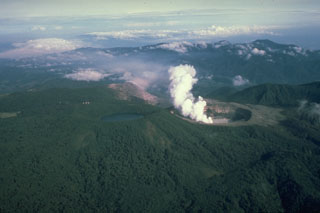Report on Poas (Costa Rica) — 23 April-29 April 2025
Smithsonian Institution / US Geological Survey
Weekly Volcanic Activity Report, 23 April-29 April 2025
Managing Editor: Sally Sennert.
Please cite this report as:
Global Volcanism Program, 2025. Report on Poas (Costa Rica) (Sennert, S, ed.). Weekly Volcanic Activity Report, 23 April-29 April 2025. Smithsonian Institution and US Geological Survey.
Poas
Costa Rica
10.2°N, 84.233°W; summit elev. 2697 m
All times are local (unless otherwise noted)
The Observatorio Vulcanológico y Sismológico de Costa Rica-Universidad Nacional (OVSICORI-UNA) reported frequent explosions and ash-and-gas plumes at Poás during 23-29 April. Seismicity, specifically background tremor, had decreased on 17 April and remained at stable levels with increases related to eruptive events during 21-23 April. The number of long-period events increased, and occasional periods of harmonic tremor began to be recorded on 21 April. Analysis of ash showed an increased proportion of juvenile material. Inflation continued to be detected.
Eruptive events at 0529 and at 0744 on 23 April generated ash-and-gas plumes that rose at least 3 km and 1 km above the crater rim, respectively. Each event lasted about five minutes. The plumes drifted SW and NE, causing ashfall in areas downwind including Belén, Alajuela (20 km S), Palmares (27 km SW), San Rafael, and San Pedro de Poás (14 km S). During 23-24 April significant and almost continuous gas-and-steam plumes with some ash rose from the crater and drifted mainly SW. Incandescence at the vents was visible at night. A small, one-minute-long eruptive event at 0107 on 24 April produced a plume that rose 1 km above the crater rim and drifted NE. Ballistics around 250 degrees Celsius were ejected to the E. A larger event was recorded at around 2030. A period of moderate-to-intense activity began at 2312 on 25 April and intensified at 2322; an ash-and-gas plume rose 1 km above the crater rim and drifted W. Incandescent material, about 300 degrees Celsius, was ejected from the vents onto the crater floor and cooled quickly. Activity was again intense during 0230-0420 on 26 April based on seismic data. During 0500-0600 hot blocks were observed being ejected from Boca C. Ash-and-gas plumes rose a few hundred meters to 1 km above the crater rim and drifted in variable directions. Almost continuous gas-and-steam emissions from both Boca A and Boca C during 27-28 April rose as high as 1 km above the crater rim. The emissions were punctuated by pulses of ash that rose 500 m and drifted in variable directions on 27 April and small eruptive pulses on 28 April that ejected incandescent material from the vents. Sulfur dioxide emissions were 2,000-10,000 tons per day. Overnight during 28-29 April almost continuous emissions rose 300 m from both vents and drifted SW; the emissions contained a smaller amount of ash than during recent days. The volcano’s Alert Level remained at 3 (the second highest level on a four-level scale) and the Aviation Color Code remained at Orange (the second highest color on a four-color scale).
Geological Summary. The broad vegetated edifice of Poás, one of the most active volcanoes of Costa Rica, contains three craters along a N-S line. The frequently visited multi-hued summit crater lakes of the basaltic-to-dacitic volcano are easily accessible by vehicle from the nearby capital city of San José. A N-S-trending fissure cutting the complex stratovolcano extends to the lower N flank, where it has produced the Congo stratovolcano and several lake-filled maars. The southernmost of the two summit crater lakes, Botos, last erupted about 7,500 years ago. The more prominent geothermally heated northern lake, Laguna Caliente, is one of the world's most acidic natural lakes, with a pH of near zero. It has been the site of frequent phreatic and phreatomagmatic eruptions since an eruption was reported in 1828. Eruptions often include geyser-like ejections of crater-lake water.
Source: Observatorio Vulcanologico y Sismologico de Costa Rica-Universidad Nacional (OVSICORI-UNA)

